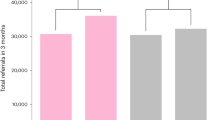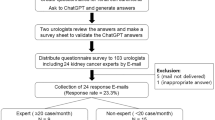Abstract
In recent years, due to the effects of societal aging, the demand for health-related consultations has been increasing. Recently developments in information technology have made it possible to conduct care consultations by Internet telephony and chat programs. In this study, we propose a remote consultation system that incorporates a collocation dictionary.
You have full access to this open access chapter, Download conference paper PDF
Similar content being viewed by others
Keywords
1 Background
In recent years in Japan, the demand for consultations related to health and nursing care have increased as society has aged. In 2015, Japan’s elderly population (those 65 years and older) was 33.84 million people, a record high 26.7 % of the total population [1]. In addition, for the first time, the population of those more than 80 years of age has exceeded 10 million people. Japan has the highest proportion of elderly citizens among developed countries.
In addition to these age-related demands on the care system, the Tohoku region suffered extensive damage during the Great East Japan Earthquake, and this, in concert with other problems, has led to the proposal of a system of regional comprehensive support centers to support elderly residents. The number of health consultations reported for fiscal year 2013 was 17 % higher than that for fiscal year 2011 [2].
In the current system, long-term-care support specialists provide services related to care support, and this is their primary occupation. As part of care, the specialists assist system users, their families, and other professionals, in making appropriate decisions in response to various situations. Recent developments in information technology have resulted in care consultations being conducted via Internet telephony or chat applications, which facilitates remote welfare service. Remote consultations are not used in many fields. For example, remote support for computer users (and particularly for elderly users) is widely available [3]. In addition, research into systems to support remote consultation has been carried out in the financial and medical fields in recent years. In line with this trend, systems for remote provision of financial and legal counseling services have been developed [4].
In the field of health care, the characteristics of remote consultation, in which patients (who are not medical professionals) may live in sparsely populated areas and yet still have problems, have been addressed with the result that several remote providers may collectively provide diagnosis and write a treatment plan [5, 6]. In line with this, the form of care provision has also diversified.
Under these circumstances, the following issues may affect the care manager and the care recipient. (1) The care support specialist cannot successfully talk with the family. (2) Long-term-care support specialists do not know the status of the care recipient. (3) Inexperienced long-term-care support specialist may not be able to recognize or diagnose problems. Additional problems may arise from differences in the abilities of care managers.
Communication with long-term-care support specialists may cause anxiety in some care users and their families. During remote consultation by asynchronous media, such as e-mail, time lags will occur. To overcome this, synchronous communication via telephone, such as the use of a call center system, has been the conventional solution. However, in recent years, various tools to mitigate the problems with asynchronous consultation have emerged, such as electronic bulletin boards. However, during nursing consultations, the levels and areas of knowledge will differ significantly between providers (as experts) and recipients (as lay people). Consequently, large differences in effectiveness are seen between different types of support tools.
Additionally, when care recipients consult with experts, there is often a difference in understanding of the words used according to the environment and because of the difference in position. This may result in consultations that are not smooth, as occurs in communication between different cultures (here, the culture of health experts and that of care recipients). In addition, most people seeking a consultation know little about long-term care. Because of this, they can only listen to the explanation given by specialists and may not feel satisfied with the consultation.
In this study, we propose that communication can be facilitated by bridging the knowledge gap between experts and recipients. For this purpose, we apply a collocation dictionary to remote consultations. In addition to the usual steps for a consultation, reference to the collocation dictionary eases understanding for the person seeking consultation. Additionally, the collocation dictionary can act as a reference during consultation and to improve understanding. By allowing differences in the perception of the keywords to be noticed, it becomes possible to prevent in the consultation.
To generate the collocation dictionary, the sentences of experts are processed by text-mining techniques (see Sect. 5). We propose a method of using the generated dictionary to support communication during remote consultation. The collocation dictionary consists of co-occurrence relations between words, with software presenting these words. In the experiment, we performed pseudo-experiments between an expert consultant and a lay consultee, using the collocation dictionary as a supplement to Internet telephony (Skype). During the consultation, the consultee could reference words from the collocation dictionary in a visual style when desired. As a result, we have identified areas of effectiveness and challenge for use of a collocation dictionary in this way.
2 Previous Research
Iino (of our laboratory) proposed the use of a collocation dictionary to facilitate consultation by deepening mutual understanding [7]. In this study, we experimentally tested the use of a collocation dictionary. However, because of the lower number of trials, and instability in the system and dataset, we were unable to verify the effectiveness of the system.
3 Collocation Dictionary
The collocation dictionary used in this summarizes co-occurrence information for basis text written by experts. Co-occurrence occurs whenever two substrings appear at the same time in any larger string. The collocation dictionary is created by ranking the strength (frequency) of co-occurrences. This makes it possible to generate the distinctive patterns and relations from given sentences. In this study, sentence-level communication is considered, and visual display of the sentences is assumed to improve utility.
4 Conceptual Basis
The basic concept of this study is that, at the time of remote consultation, the effects of knowledge difference between people belonging to different cultures (here, experts and lay people) can be ameliorated by use of a collocation dictionary and that this will facilitate effective communication.
5 Proposed Method
We conducted the same experiment as in previous studies [7], and so it was not possible to quantitatively verify the effectiveness of using the collocation dictionary for remote consultation. Therefore, we performed a qualitative review of the experiment by interview of participants. As a new proposed method, when extracting the collocation information (the KH Coder software package was used for this), irrelevant information is eliminated with the aim of limiting the amount of information used to prepare the collocation dictionary.
6 Experiment
6.1 Preparing the Experiment
In this experiment, we applied the text mining feature of KH Coder to the encyclopedia of care [8] to extract visual collocation information. Then, the produced visual information was extracted by a graphics tool to create the collocation dictionary. This dictionary was used in the experiment (Fig. 1).
6.2 Experimental Method
One participant was designated as the expert, and six participants were each designated as a consultee. First, trials were performed without using the collocation dictionary. Then, trials were performed with using the collocation dictionary. The method of the experiment is to distribute the scenario in advance, which allows participants to fully understand their roles. The consultees are told to begin with the position “I have received certification that I need long-term care, but I don’t know what to do” in chat (Skype) with the expert and to ask questions for clarification. The expert is to answer that question while introducing the various systems to the consultee. Participants acting as consultees were instructed that when they did not understand the expert’s answers, they should ask further questions. When there are no more questions, the interview ends. When using the collocation dictionary, it was displayed in a separate window from the chat screen during the consultation. When not using the collocation dictionary, no references were used. After the experiment, we asked those in the role of consultee to answer a questionnaire (Fig. 2).
6.3 Experimental Result
After the experiment, we administered a survey questionnaire to participants who had acted as consultees and then interviewed them. The questionnaire items ask for a rating on a 5-point Likert-like scale of the following: depth of consultation, degree of focus, visibility of the collocation dictionary, and effectiveness of the collocation dictionary. In addition, the number of questions and length of consultation was extracted for each consultation from logs, and the averages were calculated (Figs. 3 and 4).
As a result, use of the collocation dictionary seems to improve level of understanding, degree of focus, and reported effectiveness. The average consultation time and the average number of questions asked were both increased by using the dictionary. Interviews after the experiment confirmed that using the collocation dictionary improved the degree of focus, resulted in more questions, and achieved better understanding of the consultation. However, the collocation dictionary was seen as difficult use when trying to find words of interest (Table 1).
7 Consideration
From the experimental results, it was possible to verify the usefulness of referring to the collocation dictionary. Also, communication was improved in that the number of questions to the expert was increased, which indicates to us that the quality of the consultation was improved. However, feedback on the experiment indicates that the visibility of the system needs to be improved. In particular, we think that it is necessary to improve the procedure used when search for information. Currently, when the words of the expert are unclear, the collocation dictionary must be visually scanned. Because of this, when the amount of information is increased, it becomes difficult to explore the information. To address this, a method to display the information by using a search function should be considered. This would allow instant display of the necessary information, which we think would broaden the potential of the collocation dictionary.
8 Conclusion
Because this study used students as participants, the results do not provide useful data about actual environments. As a next step, we will collect a larger set of data from more participants and consider actual on-site usage. Additionally, we will implement a search function for the collocation dictionary before the next experiments.
References
Ministry of Internal Affairs and Communications (2015). http://www.stat.go.jp/data/topics/topi900.html. Accessed 20 Oct 2015
Kyodo News (2014). http://www.47news.jp/CN/201409/CN2014091001001721.html. Accessed 20 Oct 2015
Mori, Y., Fujimaru, N., Egashira, Y.: Online consultation provided by a support software for PC2: a case of elderly users attempt
Toshiyuki, I., Yoshihiro, A., Junichi, K., Tsutomu, M.: Remote Consultation and Contract systems using video phone. In: IPSJ 2006, pp. 85–90, 14 Sept 2006
Gotoh, T., Takayama, T., Ishiki, M., Ikeda, T.: A support system to consult remote another doctor on assessment and/or medical treatment plan when a doctor has patient not in his/her major. IPSJ 68, 629–936 (2005)
Bratan, T., Clarke, M., Jones, R.W.: Optimum design for teleconsultation systems. In: 27th Annual International Conference of the IEEE Engineering in Medicine and Biology Society EMBS, Shanghai, China from 1-Sep-2005 to 4-Sep-2005, pp. 2178–2182 (2005)
Tomotaka, I., Yajima, H.: Communication support system for co-occurrence dictionary. Master’s thesis. Tokyo Denki University (2011)
Yuichi, S.: Encyclopedia of care. Subarusya (2008)
Acknowledgement
We thank students at Tokyo Denki University who participated in the experiment.
Author information
Authors and Affiliations
Corresponding author
Editor information
Editors and Affiliations
Rights and permissions
Copyright information
© 2016 Springer International Publishing Switzerland
About this paper
Cite this paper
Yaguchi, R., Yajima, H. (2016). Communication Support via a Collocation Dictionary. In: Kurosu, M. (eds) Human-Computer Interaction. Novel User Experiences. HCI 2016. Lecture Notes in Computer Science(), vol 9733. Springer, Cham. https://doi.org/10.1007/978-3-319-39513-5_15
Download citation
DOI: https://doi.org/10.1007/978-3-319-39513-5_15
Published:
Publisher Name: Springer, Cham
Print ISBN: 978-3-319-39512-8
Online ISBN: 978-3-319-39513-5
eBook Packages: Computer ScienceComputer Science (R0)








